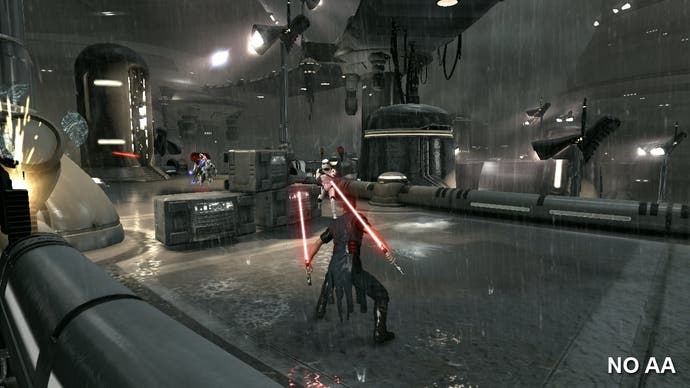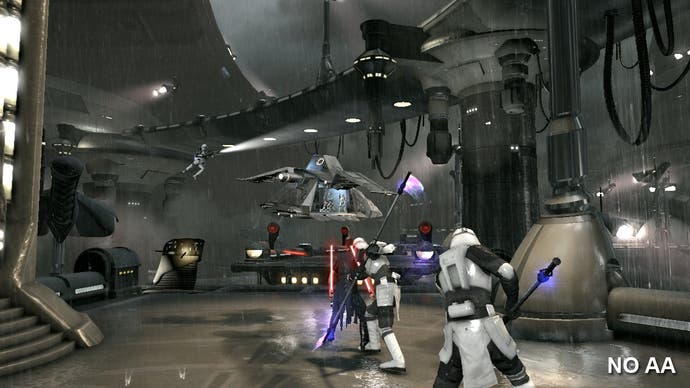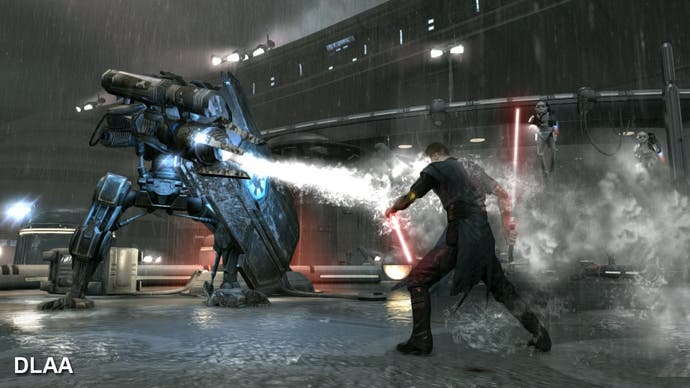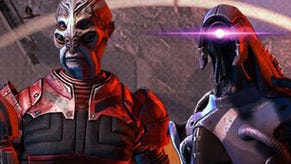Lucas explains Force Unleashed II tech
"Almost identical on both platforms."
LucasArts has contacted Digital Foundry to talk about the tech behind the forthcoming Star Wars: The Force Unleashed II, based on points raised in our PS3/360 demo showdown.
In that feature we said that the new game is an extremely close cross-platform project, which looks absolutely fantastic thanks to some great art in concert with a state-of-the-art rendering engine.
There are differences between the two platforms that we spotted in the demo code - higher-precision motion-blur and edge-detection on PS3 up against a slightly smoother performance level across the run of play on Xbox 360, along with a couple of other minor curiosities revolving around lightsabers and textures. But in short, it's very close indeed - something LucasArts is keen to emphasise.
LucasArts senior rendering engineer Dmitry Andreev writes:
"When we started with the TFUII project, the direction we chose was quite clear and strong on the rendering side – to make the best multi-platform experience possible on both PlayStation 3 and Xbox 360; to squeeze as much power out of them while trying to match the visual look as close as possible, and do it with only the small team of three rendering engineers.
"I don't know how all those screenshots and comparisons I am finding on the internet are done... With 99.9 per cent confidence I can confirm that the game looks (almost) identical on both platforms. In fact, I have all captures right in front of me (the PS3 and Xbox 360) and if you don't know which one is which, then you can't tell the difference.
"Component and HDMI signals make a difference, so I would assume that most of the reviews don't compare the game under the same conditions. In another case, one would look at the shot that was done in motion so the textures were slightly blurred at that moment, with the one on another console which had a different condition, and would say that the textures are in lower resolution. [But] all the textures are in the same resolution, with the same anisotropic filtering settings and mipmap levels.
"We also make sure that the frame rate stays at 30FPS with as minimal drops as possible on both platforms so some dynamic performance adjustments are made, thus you have to really compare the game under the same conditions. On average, both platforms perform the same. Sometimes the Xbox 360 drops a little, sometimes the PS3. But we were quite strong about keeping the frame-rate and quality the same.
"There are some little differences in motion blur and depth of field implementations that can lead to some artifacts, but it's always about compromises between the quality and performance. On the Xbox 360, the motion blur solution is slightly tweaked for performance and can produce some low-res artifacts under conditions when a foreground object moves against a static background.
"Those cases are very rare and not very apparent in motion. PlayStation 3 doesn't have this issue as it's minimised a lot more and almost impossible to see. In most of the cases it is incorrect to look at still images as it's the quality per unit of time that matters most. It should be observed in motion.
"Now, why is it almost identical?
"Unfortunately, there are two bugs ("features") that made it through: Lightsabers are a little fatter on the PS3 which some people happen to like more, and there is no tension map on the character's face in cut-scenes on the PS3. This is not because of any technical problem or hardware constraint of the PlayStation 3. Just a bug.
"Regarding the anti-aliasing that's true that in general there are not that many high-contrast edges in the demo, but the algorithm is designed to fix-up mostly edges with noticeable local contrast. In other words, if there is possibility of seeing any kind of aliasing or jaggies, it will fix it up leaving the ones that are not noticeable untouched.
"Here are some examples of what the original picture of that level without any AA looks like and Xbox 360 implementation of DLAA. The PlayStation 3 version has slightly higher quality on the long edges though."






There are some interesting points here from Andreev, in particular his comments on DLAA - the directional anti-aliasing system employed by The Force Unleashed II. The results of it in the demo were extremely impressive, but we didn't really want to comment on it more fully until we'd seen the full game with the technique put through its paces across a range of environments.
Andreev is keeping his cards close to his chest on how DLAA works, but did want to present a few points about his technique in comparison to conventional MSAA and the MLAA system used on God of War III:
MSAA gives great results but is highly expensive on consoles and doesn't work well with deferred techniques. On the other hand, one can argue that MLAA gives better results on still images which I would agree with, but the difference is in details.
- "MLAA has only been shipped on PlayStation 3 at the moment and some advanced implementations take about 4ms on 5 SPUs. There are some attempts to implement it on Xbox 360 but they start at 3.75ms and up.
- "MLAA has serious stability issues which results in popping pixels and other temporal artifacts. Configuration of the edges changes in time with changing local conditions, for instance, when the edge passes across some noisy background.
- "To improve temporal stability some use additional data like depth or normal maps. But that approach has other issues, mostly with different kind of lighting when the light "wraps around" the object and creates anti-aliasing effect of its own. In this case depth information assisted MLAA creates extra aliasing when there is no visible aliasing present. In TFUII this is very common situation as well as in the demo level.
"Thus when any comparion is made, we should keep in mind the following numbers. Typical execution times of DLAA in our current implementation are:
- "Xbox 360: 2.2 +/- 0.2ms @ 1280x720
- "PlayStation3 (5 SPUs): 1.6 +/- 0.3ms @ 1280x720"
In short, Andreev's chosen anti-aliasing solution is the right solution for his (multi-platform) game, and it's certainly very interesting to see a new technique deployed in a shipping game that produces such outstanding results. As we talked about earlier this year in our anti-aliasing piece, it's fascinating to see developers moving away from hardware AA towards custom solutions that often provide a superior effect.
To pick up a couple of his other points, Digital Foundry works entirely from full-range RGB HDMI sources. Our performance analyses are based on direct, lossless, digital captures from the output of each console - it's the only way we can guarantee that the measurements are correct. Both sets of data from both consoles are processed in exactly the same way.
Andreev's right though: like-for-like testing is the ideal but there are few occasions when this is possible. Cut-scenes can help of course in many (but not all) cases, but extended gameplay clips are the best method available for us to test overall performance across a range of scenarios. It's not entirely like-for-like of course, but it's still a worth including as an overall indication of the gameplay experience, and it's a technique often used by PC benchmarking websites in ascertaining GPU performance. As regular readers will know, in full Face-Offs, we typically like to include both forms of measurement where possible.
Of course, Andreev is also quite right to point out that effects should be judged in motion (we did point out that the motion blur difference is only really noticeable on fast pans involving movement of the whole screen) but at the same time still-shot analysis helps explain how things work, and how developers adopt different strategies for certain effects on each platform - which we find very interesting.
It's good to know that the minor differences we did find were indeed bugs (which will hopefully be fixed via patches or bundled into DLC updates) as per our initial thoughts, but Andreev's emphasis on the crucial aspects that are entirely like-for-like across both consoles are well worth bearing out too. Considering how different the PlayStation 3 and Xbox 360 are from an architectural standpoint, the fact that both versions of an advanced title like The Force Unleashed II are so close is an impressive achievement.
We're still waiting for the final game, but as we said in the original piece, if you've not downloaded the demo yet you really should check it out - it's shaping up to be something rather special.






